Effect of Walnut-Shell Additive on the Structure and Characteristics of Concrete
Abstract
1. Introduction
2. Materials and Methods
2.1. Materials
2.2. Methods
3. Results and Discussion
3.1. Study of the Physical and Mechanical Characteristics of Concrete
3.2. Analysis of the Microstructure of Samples of Hardened Cement Paste with Partial Replacement of Crushed Stone with Walnut Shells
3.3. Discussion
4. Conclusions
- (1)
- In the course of the study, the main parameters and characteristics of the organic large-walnut-shell aggregate used to partially replace the mineral components of the concrete mixture, were determined.
- (2)
- According to the results of the experiments, the dependences of the physical and mechanical characteristics of concrete on the amount of added walnut shell and the microstructure of the composite, were established. Improving the properties of concrete, due to the partial replacement of coarse mineral aggregate with a vegetable analogue from walnut shells, is expressed in a decrease in its weight and an increase in the CCQ. The maximum increase in strength parameters for concrete with 5% replacement of a part of the mineral coarse aggregate was: for cubic CS—2.7%, for axial CS—3.3%, for TS in bending—3.4%, and for axial TS—3.3%. The maximum decrease in the weight of concrete, at which a decrease in SC of no more than 10% was observed, reached 6%.
- (3)
- The optimal percentage for the replacement of mineral coarse aggregate with walnut shell was in the range of 5% to 10%. Increasing the CCQ in this case amounted to 6%.
- (4)
- An increase in the dosage of walnut shells from more than 10% to 30% leads to a decrease in SC of up to 45%, in weight of up to 17% and in CCQ of up to 37%.
- (5)
- The study of the resulting composition using electron-microscopy methods showed that the resulting concrete composition is effective both in terms of the characteristics of the hardened composite and in terms of its economic and environmental efficiency, compared to the control composition of concrete without the introduction of walnut shells.
Author Contributions
Funding
Institutional Review Board Statement
Informed Consent Statement
Data Availability Statement
Acknowledgments
Conflicts of Interest
Abbreviations
| BD | Bulk Density |
| CCQ | Coefficient of Constructive Quality |
| CS | Compressive Strength |
| SC | Strength Characteristics |
| TD | True Density |
| TS | Tensile Strength |
References
- Liu, C.; Wang, Y.; Gao, X.; Zhang, G.; Liu, H.; Ma, C.; Sun, J.; Lai, J. Review of the Strengthening Methods and Mechanical Properties of Recycled Aggregate Concrete (RAC). Crystals 2022, 12, 1321. [Google Scholar] [CrossRef]
- Khan, S.S.; Ali, M. Short-Term and Long-Term Needs for Sustainable Concrete—An Overview. Eng. Proc. 2022, 22, 14. [Google Scholar] [CrossRef]
- Katman, H.Y.B.; Khai, W.J.; Bheel, N.; Kırgız, M.S.; Kumar, A.; Khatib, J.; Benjeddou, O. Workability, Strength, Modulus of Elasticity, and Permeability Feature of Wheat Straw Ash-Incorporated Hydraulic Cement Concrete. Buildings 2022, 12, 1363. [Google Scholar] [CrossRef]
- Nunes, L.J.R.; Matias, J.C.O.; Loureiro, L.M.E.F.; Sá, L.C.R.; Silva, H.F.C.; Rodrigues, A.M.; Causer, T.P.; DeVallance, D.B.; Ciolkosz, D.E. Evaluation of the Potential of Agricultural Waste Recovery: Energy Densification as a Factor for Residual Biomass Logistics Optimization. Appl. Sci. 2021, 11, 20. [Google Scholar] [CrossRef]
- Ferraz, P.F.P.; Mendes, R.F.; Marin, D.B.; Paes, J.L.; Cecchin, D.; Barbari, M. Agricultural Residues of Lignocellulosic Materials in Cement Composites. Appl. Sci. 2020, 10, 8019. [Google Scholar] [CrossRef]
- Mcca_rey, R. Climate Change and the Cement Industry. Glob. Cem. Lime Mag. (Environ. Spec. Issue) 2002, 15, 19. [Google Scholar]
- Gerges, N.N.; Issa, C.A.; Sleiman, E.; Aintrazi, S.; Saadeddine, J.; Abboud, R.; Antoun, M. Eco-Friendly Optimum Structural Concrete Mix Design. Sustainability 2022, 14, 8660. [Google Scholar] [CrossRef]
- Coffetti, D.; Crotti, E.; Gazzaniga, G.; Carrara, M.; Pastore, T.; Coppola, L. Pathways Towards Sustainable Concrete. Cem. Concr. Res. 2022, 154, 106718. [Google Scholar] [CrossRef]
- Khan, K.; Salami, B.A.; Jamal, A.; Amin, M.N.; Usman, M.; Al-Faiad, M.A.; Abu-Arab, A.M.; Iqbal, M. Prediction Models for Estimating Compressive Strength of Concrete Made of Manufactured Sand Using Gene Expression Programming Model. Materials 2022, 15, 5823. [Google Scholar] [CrossRef]
- Kathirvel, P.; Murali, G.; Vatin, N.I.; Abid, S.R. Experimental Study on Self Compacting Fibrous Concrete Comprising Magnesium Sulphate Solution Treated Recycled Aggregates. Materials 2022, 15, 340. [Google Scholar] [CrossRef]
- Kathirvel, P.; Saravana Raja Mohan, K. Influence of Recycled Concrete Aggregates on the Flexural Properties of Reinforced Alkali Activated Slag Concrete. Constr. Build. Mater. 2016, 102, 51–58. [Google Scholar] [CrossRef]
- WMO. Greenhouse Gas Bulletin: The State of the Greenhouse Gases in the Atmosphere Based on Global Observations through 2018; WMO: Geneva, Switzerland, 2019; NO. 15; Available online: https://library.wmo.int/doc_num.php?explnum_id=10100 (accessed on 26 January 2023).
- Almadani, M.; Razak, R.A.; Abdullah, M.M.A.B.; Mohamed, R. Geopolymer-Based Artificial Aggregates: A Review on Methods of Producing, Properties, and Improving Techniques. Materials 2022, 15, 5516. [Google Scholar] [CrossRef]
- Jang, H.-J.; Ahn, Y.-H.; Tae, S.-H. Proposal of Major Environmental Impact Categories of Construction Materials Based on Life Cycle Impact Assessments. Materials 2022, 15, 5047. [Google Scholar] [CrossRef]
- Joyklad, P.; Yooprasertchai, E.; Rahim, A.; Ali, N.; Chaiyasarn, K.; Hussain, Q. Sustainable and Low-Cost Hemp FRP Composite Confinement of B-Waste Concrete. Sustainability 2022, 14, 7673. [Google Scholar] [CrossRef]
- Xiao, L.; Xu, Y.; Zhao, X.; Luo, J. The Developmental Anatomy on the Pericarp of Juglans Regia. Acta Bot. Boreali-Occident. Sin. 1998, 18, 577–580. [Google Scholar]
- Zhao, S.; Niu, J.; Yun, L.; Liu, K.; Wang, S.; Wen, J.; Wang, H.; Zhang, Z. The Relationship among the Structural, Cellular, and Physical Properties of Walnut Shell. Hortscience 2019, 54, 275–281. [Google Scholar] [CrossRef]
- Khadykina, E.A.; Meretukov, Z.A. Composite Material Based on Plant Raw Materials. Mater. Sci. Forum 2019, 974, 406–412. [Google Scholar] [CrossRef]
- Liu, H.; Li, Q.; Quan, H.; Xu, X.; Wang, Q.; Ni, S. Assessment on the Properties of Biomass-Aggregate Geopolymer Concrete. Appl. Sci. 2022, 12, 3561. [Google Scholar] [CrossRef]
- Marey, H.; Kozma, G.; Szabó, G. Effects of Using Green Concrete Materials on the CO2 Emissions of the Residential Building Sector in Egypt. Sustainability 2022, 14, 3592. [Google Scholar] [CrossRef]
- Venkatesan, B.; Lijina, V.J.; Kannan, V.; Dhevasenaa, P.R. Partial Replacement of Fine Aggregate by steel slag and coarse aggregate by walnut shell in concrete. Mater. Today Proc. 2021, 37, 1761–1766. [Google Scholar] [CrossRef]
- Cheng, W.; Liu, G.; Chen, L. Pet Fiber Reinforced Wet-Mix Shotcrete with Walnut Shell as Replaced Aggregate. Appl. Sci. 2017, 7, 345. [Google Scholar] [CrossRef]
- Rosas-Díaz, F.; García-Hernández, D.G.; Mendoza-Rangel, J.M.; Terán-Torres, B.T.; Galindo-Rodríguez, S.A.; Juárez-Alvarado, C.A. Development of a Portland Cement-Based Material with Agave salmiana Leaves Bioaggregate. Materials 2022, 15, 6000. [Google Scholar] [CrossRef]
- Al-Kharabsheh, B.N.; Arbili, M.M.; Majdi, A.; Ahmad, J.; Deifalla, A.F.; Hakamy, A. A Review on Strength and Durability Properties of Wooden Ash Based Concrete. Materials 2022, 15, 7282. [Google Scholar] [CrossRef]
- Hilal, N.; Mohammed Ali, T.K.; Tayeh, B.A. Properties of Environmental Concrete that Contains Crushed Walnut Shell as Partial Replacement for Aggregates. Arab. J. Geosci. 2020, 13, 812. [Google Scholar] [CrossRef]
- Husain, M.S.; Ahmad, A.; Huda, S.; Asim, M. Cost Optimization of Concrete by Replacing Fine Aggregate with Walnut Shell Powder. Int. J. Civ. Eng. Technol. 2017, 8, 82–89. [Google Scholar]
- Kamal, I.; Sherwani, A.; Ali, A.; Khalid, A.; Saadi, I.; Harbi, A. Walnut Shell for Partial Replacement of Fine Aggregate in Concrete: Modeling and Optimization. J. Civ. Eng. Res. 2017, 7, 109–119. [Google Scholar] [CrossRef]
- Mirón, S.; Wendonly, B.; Gutiérrez, R.; Salvador, R.; Orozco, M.; Eugenia, M. Alternative Material for Load-Bearing Wall with Addition of Walnut Shell. Waste Reduction. In Proceedings of the 3rd International Congress on Sustainable Construction and Eco-efficient Solutions=: Actas del 3er Congreso Internacional y 5° Nacional de Construcción Sostenible y Soluciones Eco-eficientes, Seville, Spain, 27–29 March 2017; Escuela Técnica Superior de Arquitectura; Universidad de Sevilla: Sevilla, Spain, 2017; Volume 1012, pp. 1023–1034. [Google Scholar]
- Hilal, N.N.; Sahab, M.F.; Mohammed Ali, T.K. Fresh and Hardened Properties of Lightweight Self-Compacting Concrete Containing Walnut Shells as Coarse Aggregate. J. King Saud Univ. Eng. Sci. 2021, 33, 364–372. [Google Scholar] [CrossRef]
- Ramasubramani, R.; Gunasekaran, K. Sustainable Alternate Materials for Concrete Production from Renewable Source and Waste. Sustainability 2021, 13, 1204. [Google Scholar] [CrossRef]
- Beskopylny, A.N.; Stel’makh, S.A.; Shcherban, E.M.; Mailyan, L.R.; Meskhi, B.; Shilov, A.A.; Beskopylny, N.; Chernil’nik, A. Enhanced Performance of Concrete Dispersedly Reinforced with Sisal Fibers. Appl. Sci. 2022, 12, 9102. [Google Scholar] [CrossRef]
- Shih, Y.F.; Cai, J.X.; Kuan, C.S.; Hsieh, C.F. Plant Fibers and Wasted Fiber/Epoxy Green Composites. Compos. Part B Eng. 2012, 43, 2817–2821. [Google Scholar] [CrossRef]
- Rokbi, M.; Baali, B.; Rahmouni, Z.E.A.; Latelli, H. Mechanical Properties of Polymer Concrete Made with Jute Fabric and Waste Marble Powder at Various Woven Orientations. Int. J. Environ. Sci. Technol. 2019, 16, 5087–5094. [Google Scholar] [CrossRef]
- Valášek, P.; Müller, M.; Šleger, V.; Kolář, V.; Hromasová, M.; D’Amato, R.; Ruggiero, A. Influence of Alkali Treatment on the Microstructure and Mechanical Properties of Coir and Abaca Fibers. Materials 2021, 14, 2636. [Google Scholar] [CrossRef] [PubMed]
- Beskopylny, A.N.; Shcherban’, E.M.; Stel’makh, S.A.; Meskhi, B.; Shilov, A.A.; Varavka, V.; Evtushenko, A.; Özkılıç, Y.O.; Aksoylu, C.; Karalar, M. Composition Component Influence on Concrete Properties with the Additive of Rubber Tree Seed Shells. Appl. Sci. 2022, 12, 11744. [Google Scholar] [CrossRef]
- Shcherban’, E.M.; Stel’makh, S.A.; Beskopylny, A.N.; Mailyan, L.R.; Meskhi, B.; Shilov, A.A.; Chernil’nik, A.; Özkılıç, Y.O.; Aksoylu, C. Normal-Weight Concrete with Improved Stress–Strain Characteristics Reinforced with Dispersed Coconut Fibers. Appl. Sci. 2022, 12, 11734. [Google Scholar] [CrossRef]
- Stel’makh, S.A.; Shcherban’, E.M.; Beskopylny, A.N.; Mailyan, L.R.; Meskhi, B.; Tashpulatov, S.S.; Chernil’nik, A.; Shcherban’, N.; Tyutina, A. Composition, Technological, and Microstructural Aspects of Concrete Modified with Finely Ground Mussel Shell Powder. Materials 2023, 16, 82. [Google Scholar] [CrossRef]
- Stel’makh, S.A.; Shcherban’, E.M.; Beskopylny, A.N.; Mailyan, L.R.; Meskhi, B.; Beskopylny, N.; Dotsenko, N.; Kotenko, M. Nanomodified Concrete with Enhanced Characteristics Based on River Snail Shell Powder. Appl. Sci. 2022, 12, 7839. [Google Scholar] [CrossRef]
- Shcherban’, E.M.; Stel’makh, S.A.; Beskopylny, A.N.; Mailyan, L.R.; Meskhi, B.; Varavka, V.; Beskopylny, N.; El’shaeva, D. Enhanced Eco-Friendly Concrete Nano-Change with Eggshell Powder. Appl. Sci. 2022, 12, 6606. [Google Scholar] [CrossRef]
- Jirimali, H.; Singh, J.; Boddula, R.; Lee, J.-K.; Singh, V. Nano-Structured Carbon: Its Synthesis from Renewable Agricultural Sources and Important Applications. Materials 2022, 15, 3969. [Google Scholar] [CrossRef]
- Bałys, M.; Brodawka, E.; Jodłowski, G.S.; Szczurowski, J.; Wójcik, M. Alternative Materials for the Enrichment of Biogas with Methane. Materials 2021, 14, 7759. [Google Scholar] [CrossRef]
- Yadav, V.K.; Yadav, K.K.; Tirth, V.; Gnanamoorthy, G.; Gupta, N.; Algahtani, A.; Islam, S.; Choudhary, N.; Modi, S.; Jeon, B.-H. Extraction of Value-Added Minerals from Various Agricultural, Industrial and Domestic Wastes. Materials 2021, 14, 6333. [Google Scholar] [CrossRef]
- GOST 26633 Heavy-Weight and Sand Concretes. Specifications. Available online: https://docs.cntd.ru/document/1200133282 (accessed on 7 February 2023).
- GOST 10181 Concrete Mixtures. Methods of Testing. Available online: https://docs.cntd.ru/document/1200115733 (accessed on 9 February 2023).
- Beskopylny, A.N.; Stel’makh, S.A.; Shcherban’, E.M.; Mailyan, L.R.; Meskhi, B.; Smolyanichenko, A.S.; Beskopylny, N. High-Performance Concrete Nanomodified with Recycled Rice Straw Biochar. Appl. Sci. 2022, 12, 5480. [Google Scholar] [CrossRef]
- GOST 10180 Concretes. Methods for Strength Determination Using Reference Specimens. Available online: https://docs.cntd.ru/document/1200100908 (accessed on 26 January 2023).
- GOST 24452 Concretes. Methods of Prismatic, Compressive Strength, Modulus of Elasticity and Poisson’s Ratio Determination. Available online: https://docs.cntd.ru/document/9056198 (accessed on 26 January 2023).
- GOST 18105 Concretes. Rules for Control and Assessment of Strength. Available online: https://docs.cntd.ru/document/1200164028 (accessed on 26 January 2023).
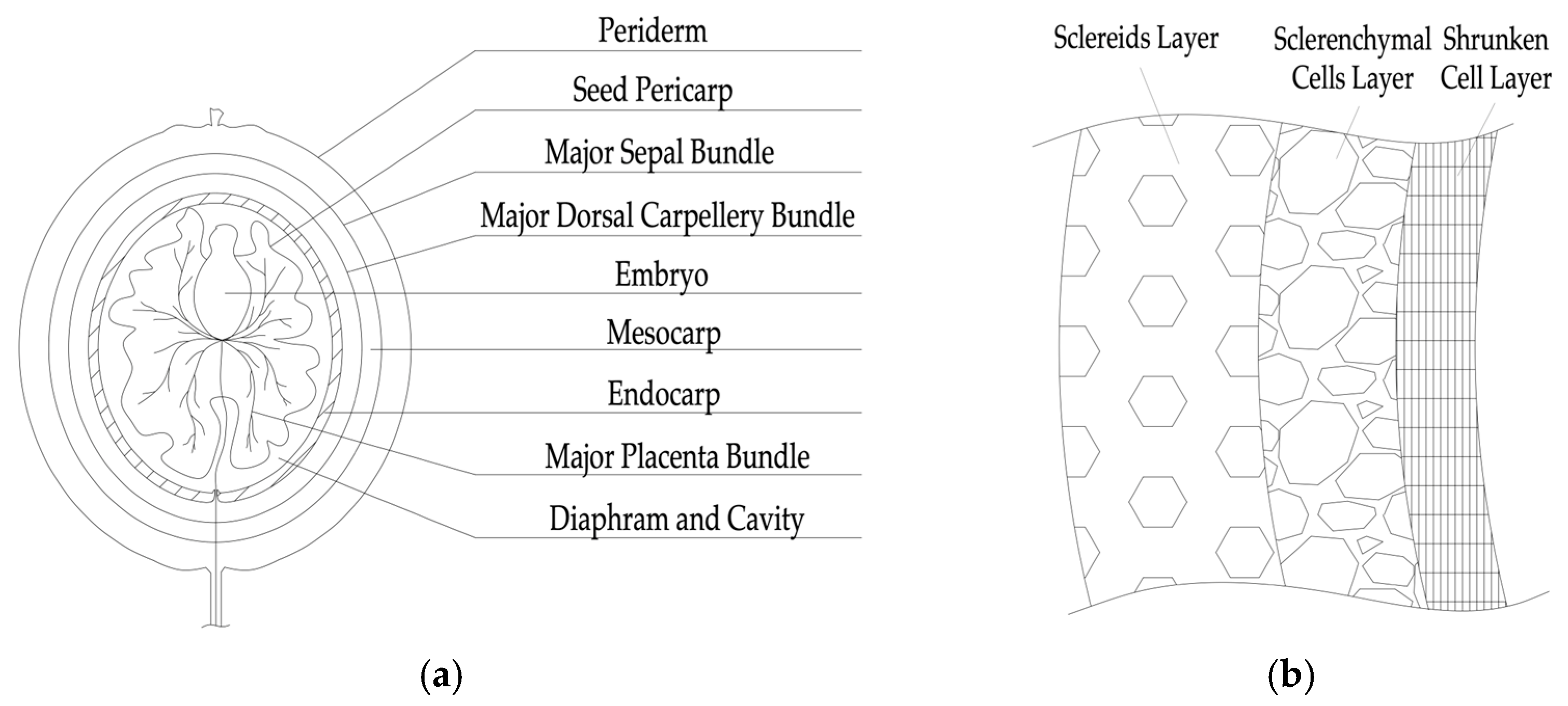
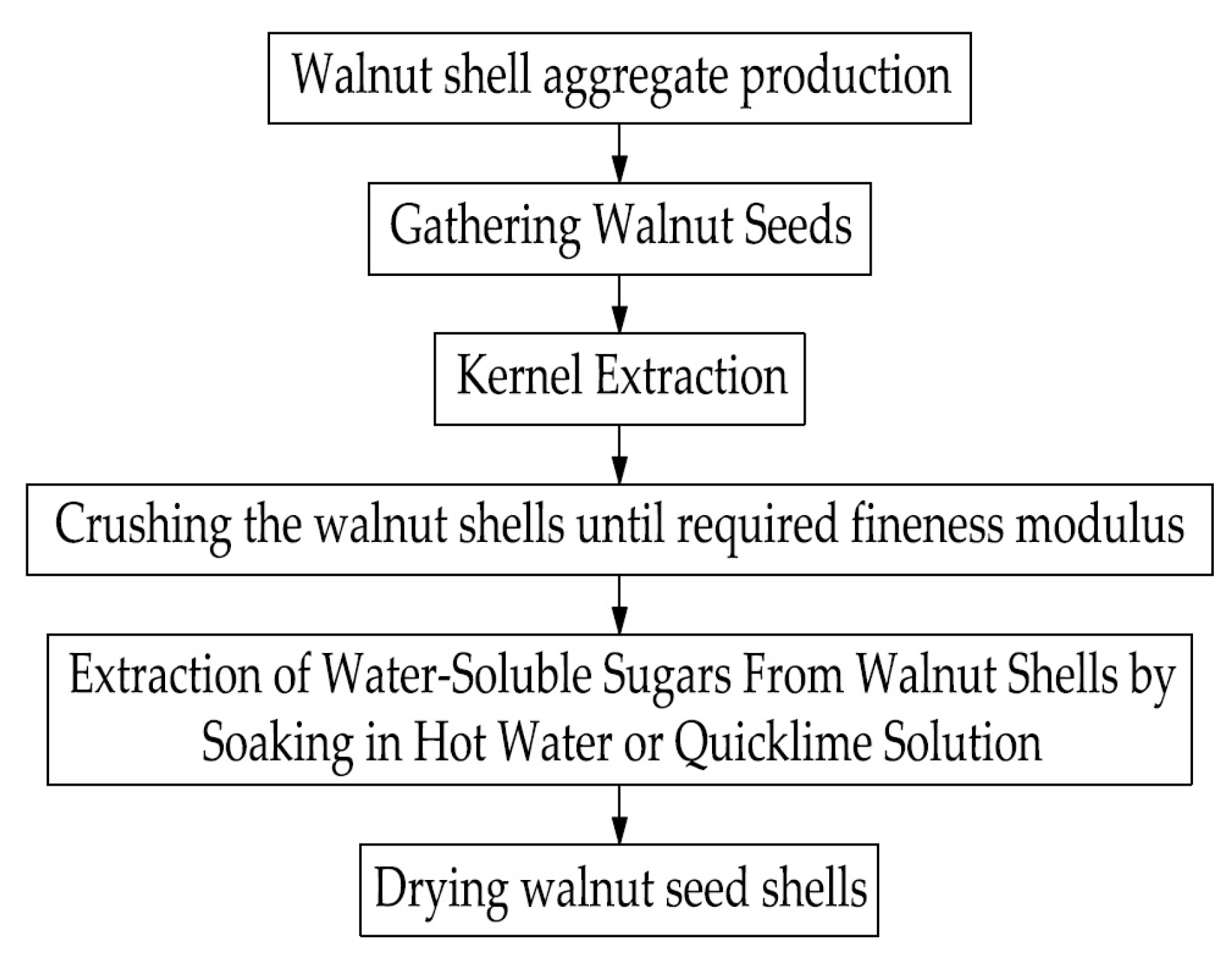

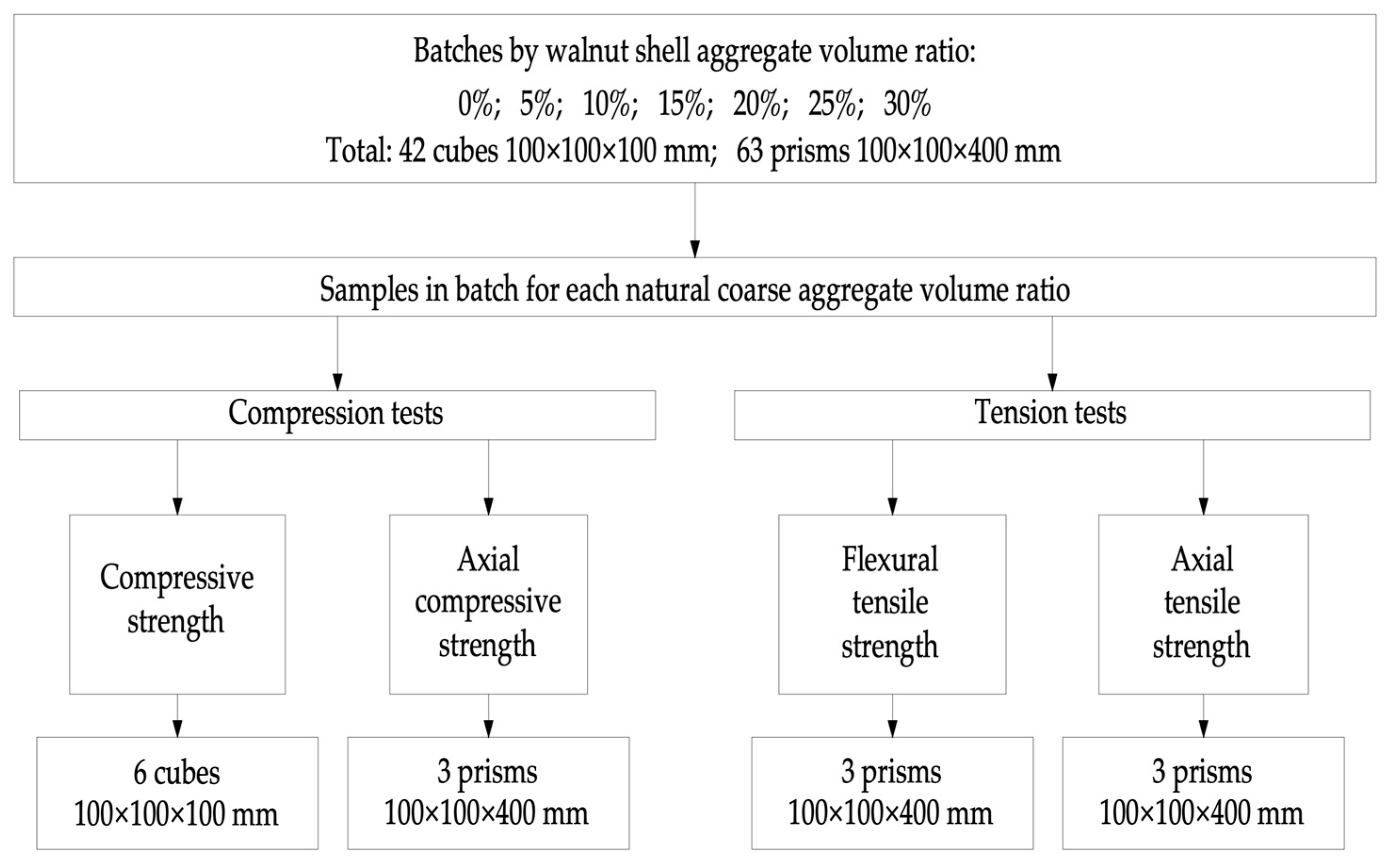

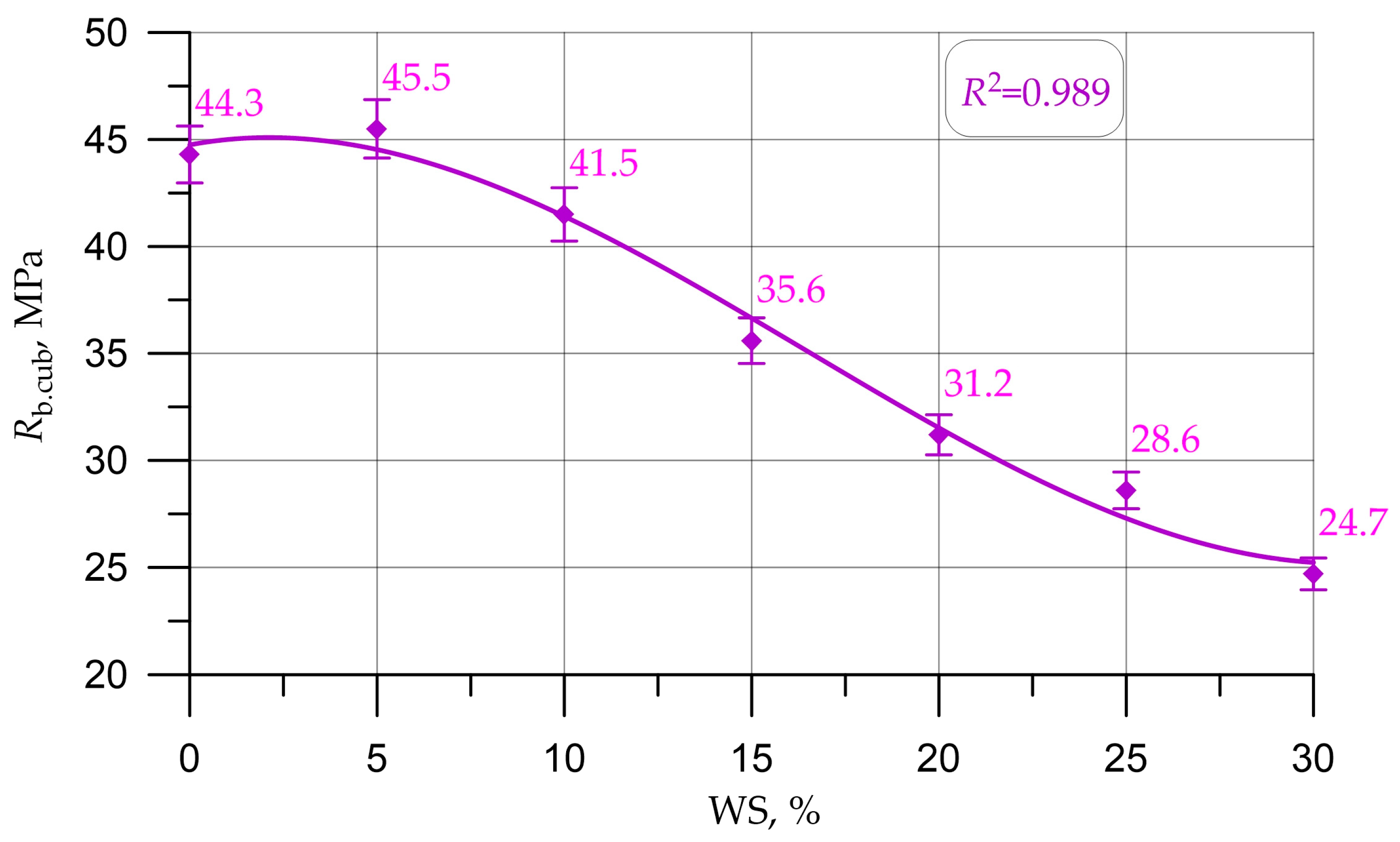
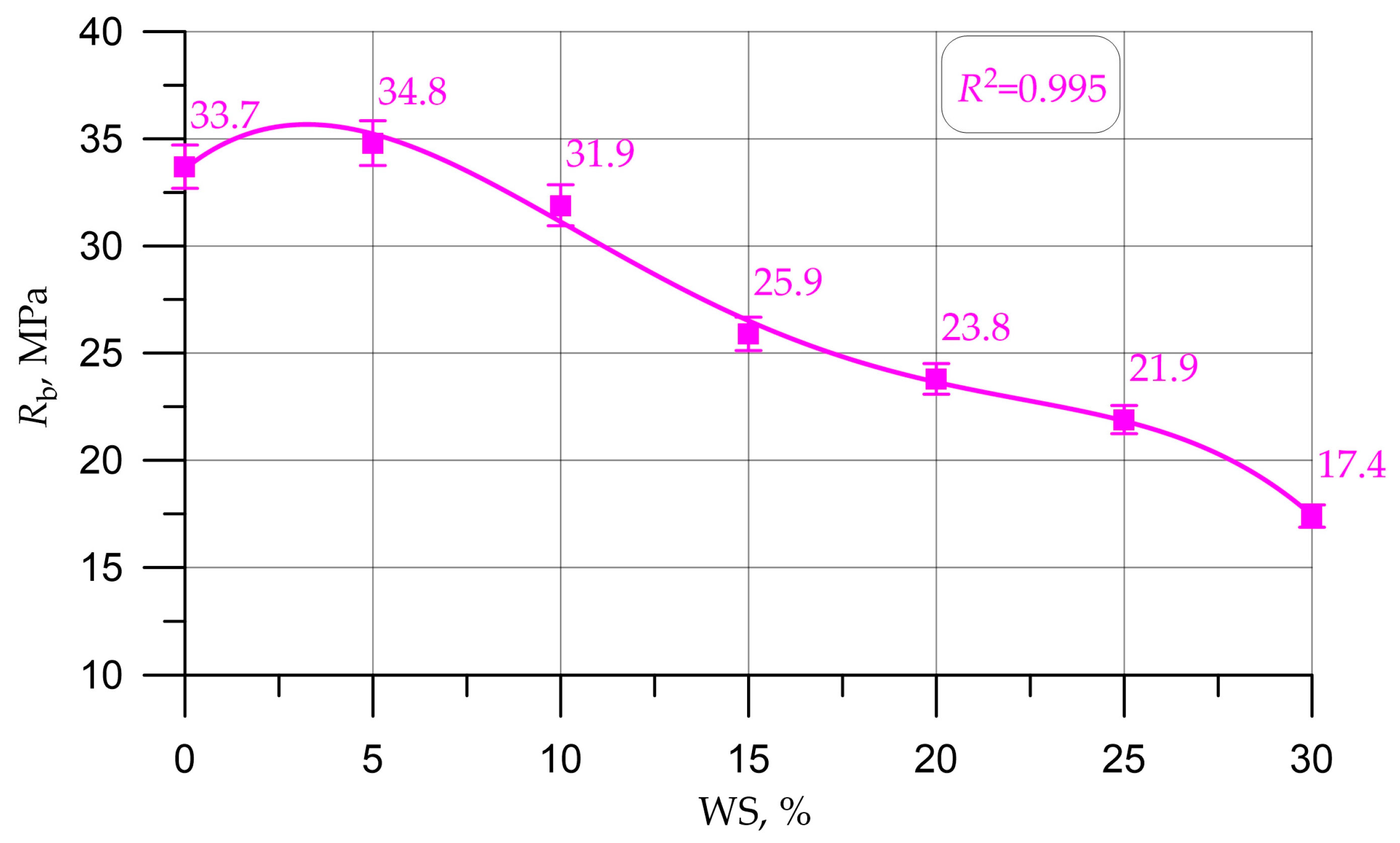
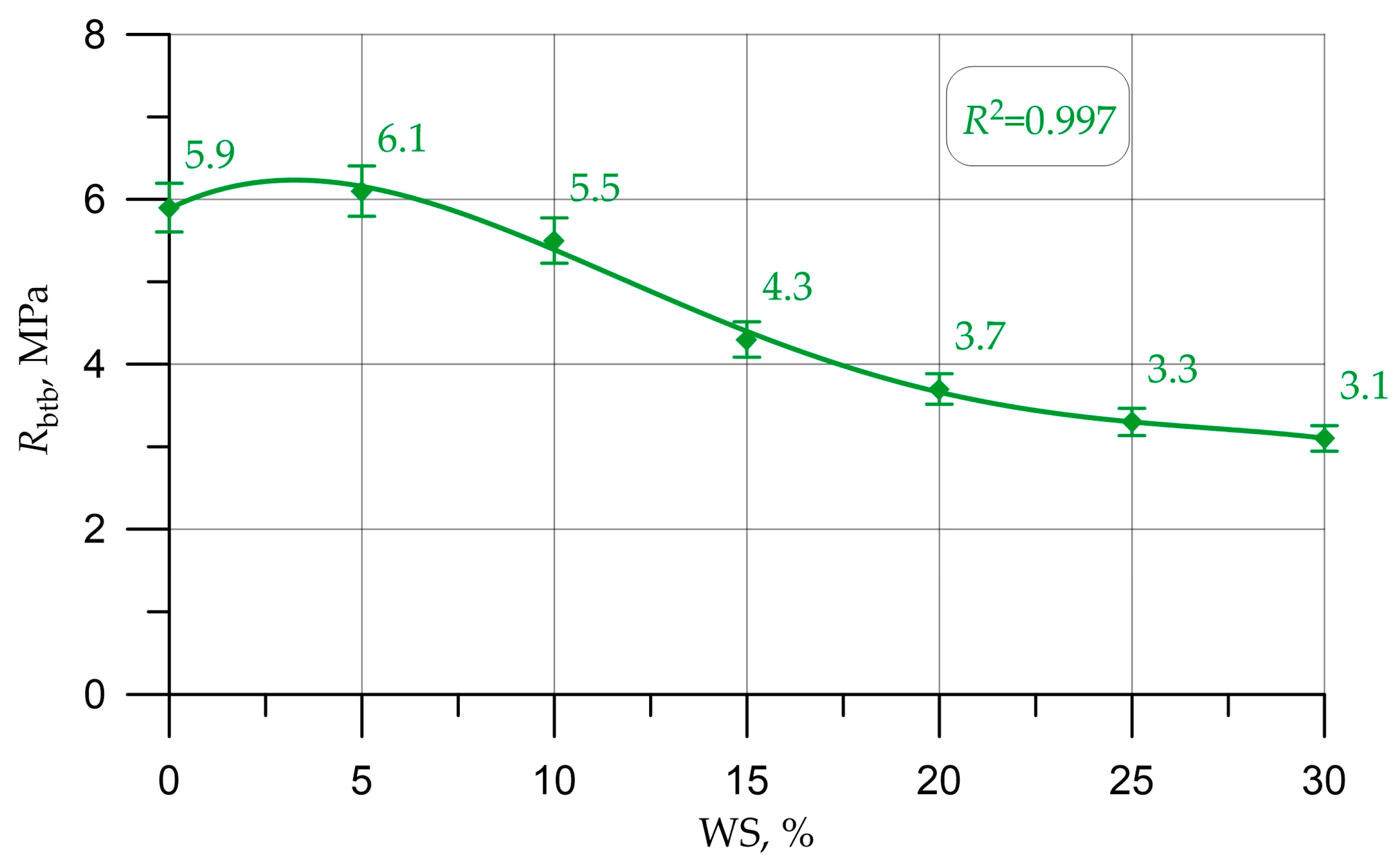
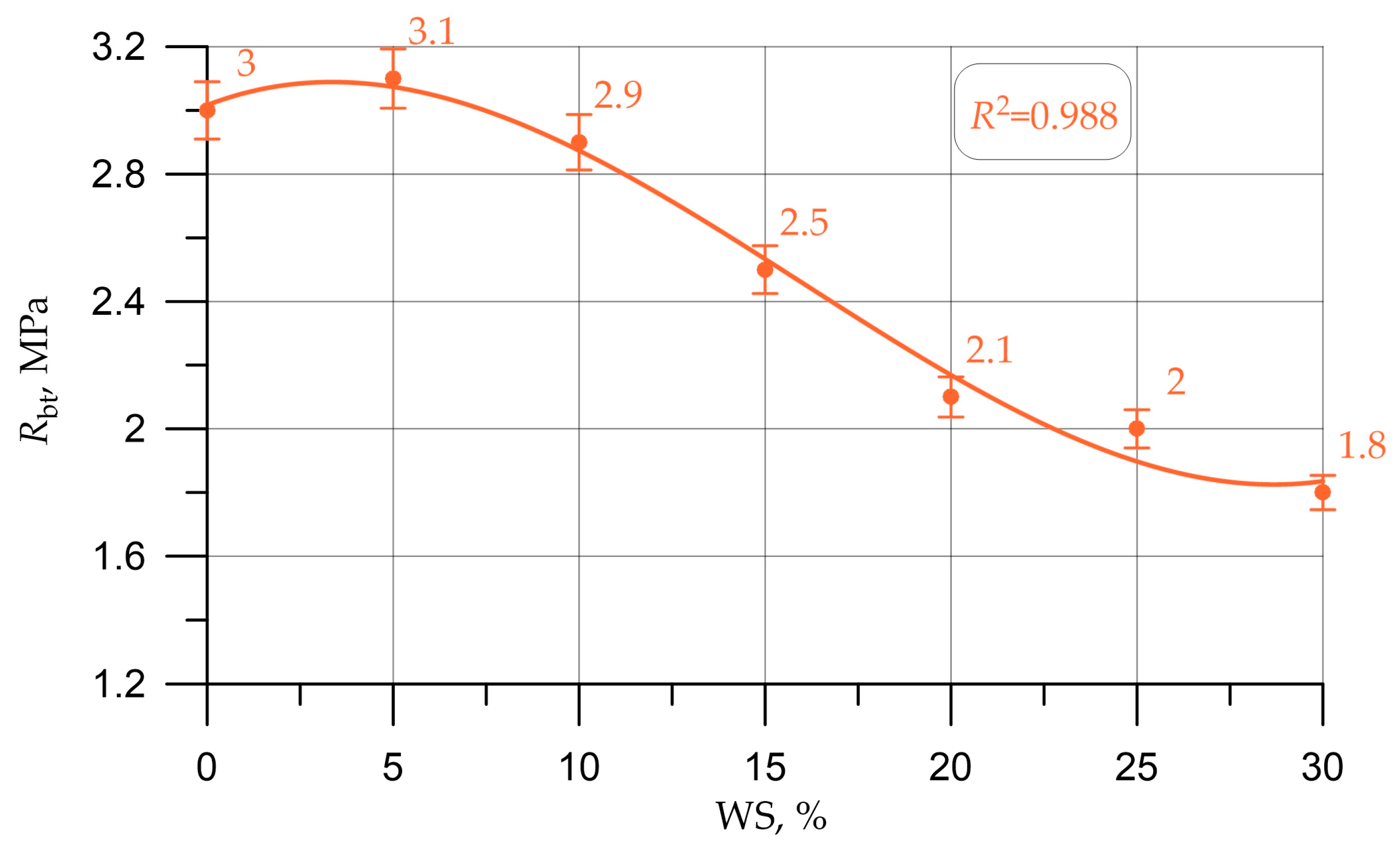

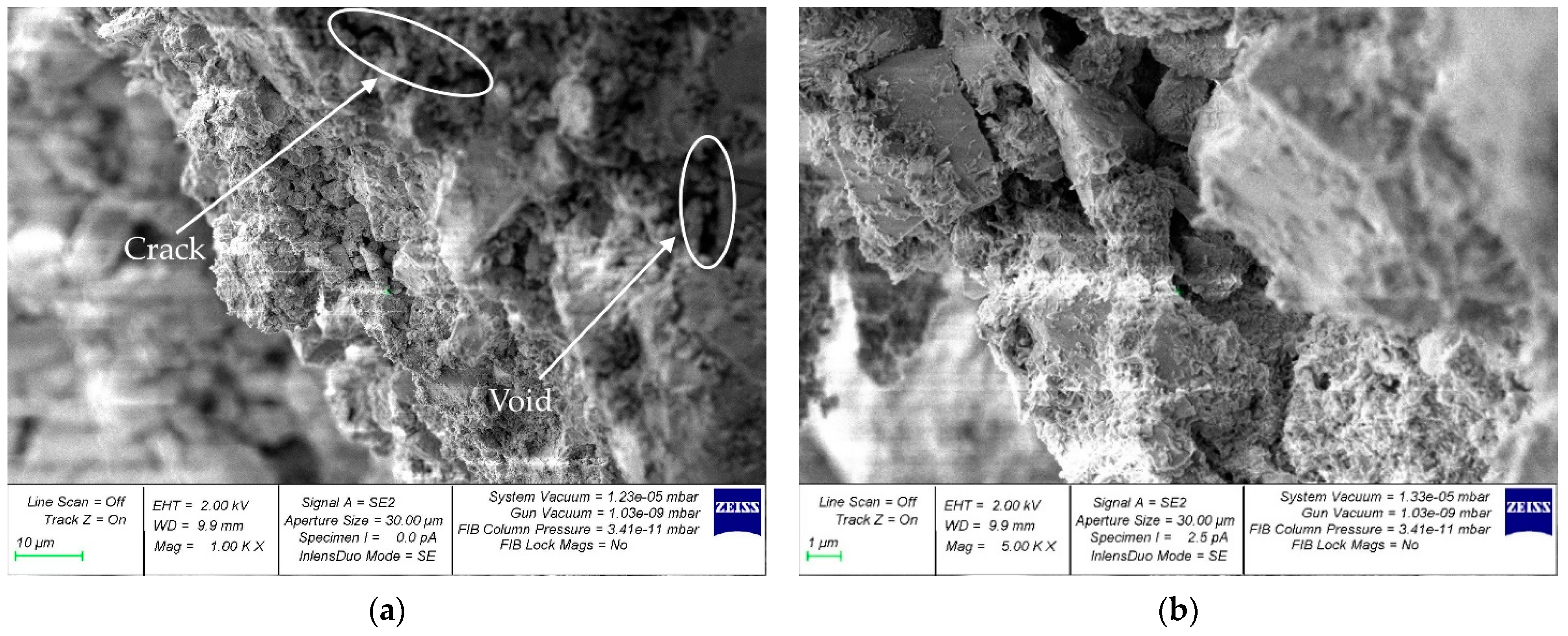
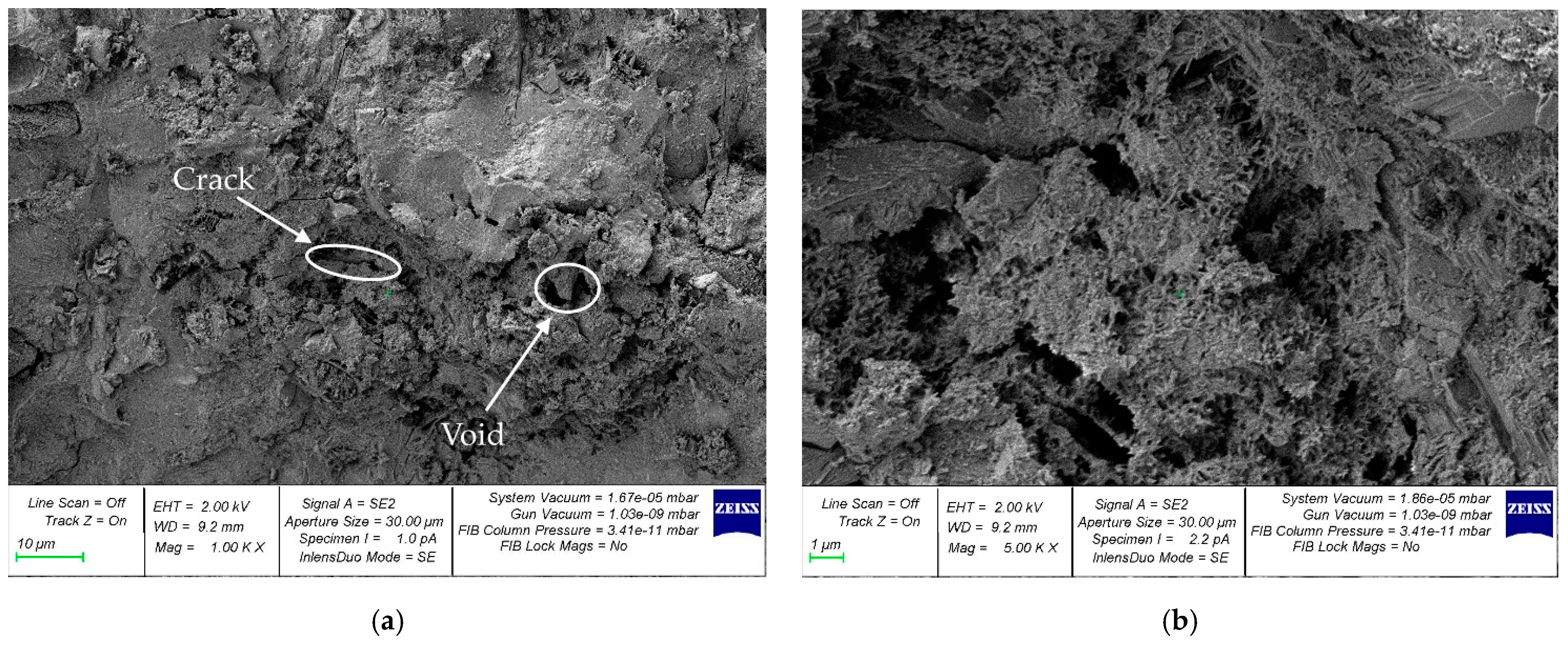
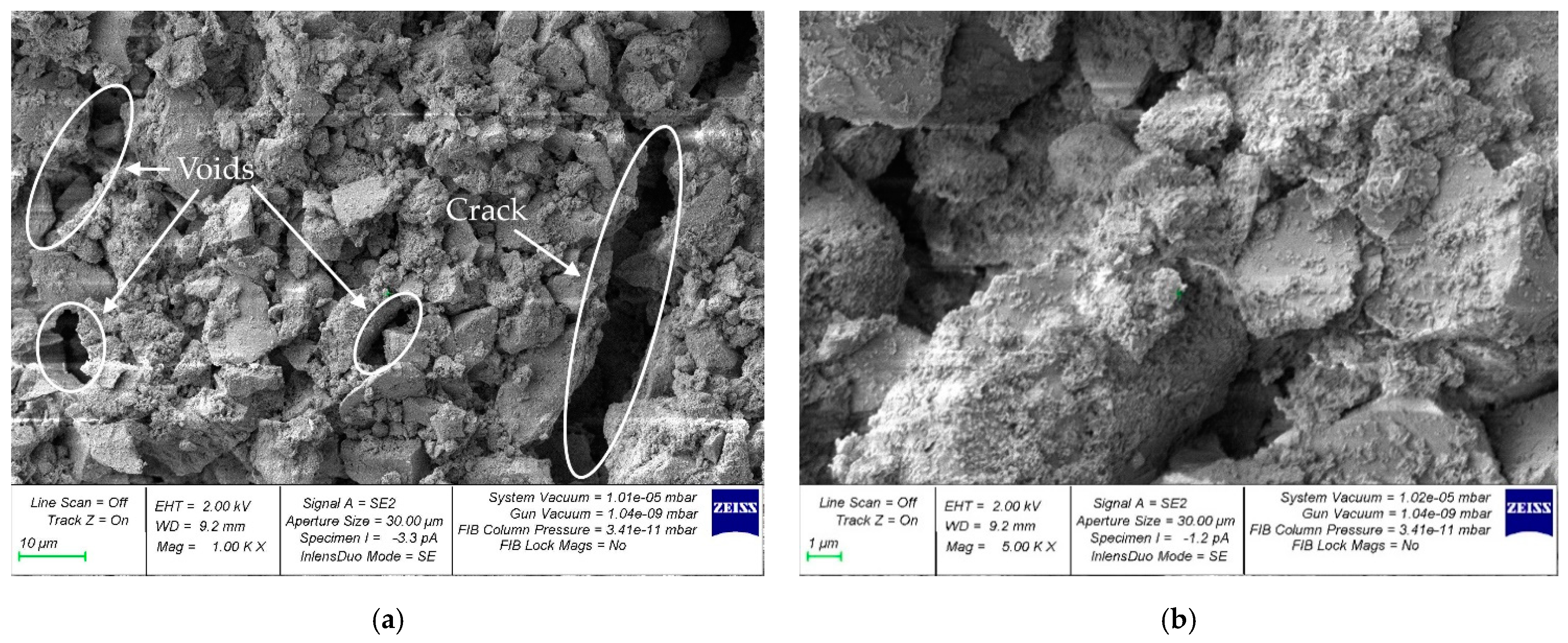
| Material Name | Specific Surface (m2/kg) | The Normal Density of Cement Paste (%) | Fineness Grinding, Passage through a Sieve No. 008 (%) | Setting Time (min) | Tensile Strength in Bending (MPa) | Compressive Strength (MPa) |
|---|---|---|---|---|---|---|
| CEM I 52.5 N produced by JSC MORDOVCEMENT (p. Komsomolsky, Russia) | 330 | 25 | 4.3 | start 165 end 230 | 4.5 (2 days) 7.8 (28 days) | 24.3 (2 days) 55.7 (28 days) |
| Aggregate’s Title | Actual Value |
|---|---|
| Quartz sand produced by Nedra (Samarskoye, Russia) | |
| Size modulus | 1.73 |
| Bulk density (BD) (kg/m3) | 1578 |
| True density (TD) (kg/m3) | 2650 |
| The content of dust and clay particles (%) | 1.1 |
| Clay content in lumps (%) | 0.15 |
| Crushed sandstone produced by Aninsky GOK (Anikin farm, Russia) | |
| Fraction size (mm) | from 5 to 20 |
| BD (kg/m3) | 1487 |
| TD (kg/m3) | 2655 |
| Crushability (% by mass) | 10.6 |
| The content of lamellar (flaky) and needle-shaped grains (% by weight) | 9.8 |
| Walnut shell (collected in Krasnodar region, Russia) | |
| Flakiness index, FI (wt. %) | 91.15 |
| Relative density (SSD) | 1.45 |
| Water absorption (wt, %) | 18.11 |
| BD (kg/m3) | 545 |
| Dry-air humidity (wt.%) | 2.01 |
| Crushability (% by mass) | 0.98 |
| The content of grains of lamellar (flaky) and acicular form (% by weight) | 48.23 |
| Component Name | Portland Cement (kg/m3) | Water (L/m3) | Crushed Stone (kg/m3) | Sand (kg/m3) | Walnut Shell, (kg/m3) | ρcm (kg/m3) | Cone Draft According to GOST 10181 [44] |
|---|---|---|---|---|---|---|---|
| Amount per 1 m3 of concrete mix | 375 | 210 | 1028 | 731 | 0 | 2344 | 8.9 |
| 375 | 210 | 976.1 | 731 | 18.8 | 2311 | 8.6 | |
| 375 | 210 | 924.8 | 731 | 37.7 | 2278 | 8.2 | |
| 375 | 210 | 873.4 | 731 | 56.5 | 2246 | 7.6 | |
| 375 | 210 | 822.0 | 731 | 75.3 | 2213 | 6.8 | |
| 375 | 210 | 770.6 | 731 | 94.1 | 2181 | 5.8 | |
| 375 | 210 | 719.3 | 731 | 113.0 | 2148 | 4.5 |
| Conerete Characteristics | ∆ in % with the Content of Coarse Walnut Shell Aggregate (%) by Volume of Coarse Aggregate | ||||||
|---|---|---|---|---|---|---|---|
| 0 | 5 | 10 | 15 | 20 | 25 | 30 | |
| (kg/m3) | 0 | –3 | –5.3 | –7.6 | –10.0 | –13.2 | –15.1 |
| Rb.cub (MPa) | 0 | 2.7 | –6.3 | –19.6 | –29.6 | –35.4 | –44.2 |
| Rb (MPa) | 0 | 3.3 | –5.3 | –23.1 | –29.4 | –35.0 | –48.4 |
| Rbtb (MPa) | 0 | 3.4 | –6.8 | –27.1 | –37.3 | –44.1 | –47.5 |
| Rbt (MPa) | 0 | 3.3 | –3.3 | –16.7 | –30.0 | –33.3 | –40.0 |
Disclaimer/Publisher’s Note: The statements, opinions and data contained in all publications are solely those of the individual author(s) and contributor(s) and not of MDPI and/or the editor(s). MDPI and/or the editor(s) disclaim responsibility for any injury to people or property resulting from any ideas, methods, instructions or products referred to in the content. |
© 2023 by the authors. Licensee MDPI, Basel, Switzerland. This article is an open access article distributed under the terms and conditions of the Creative Commons Attribution (CC BY) license (https://creativecommons.org/licenses/by/4.0/).
Share and Cite
Beskopylny, A.N.; Stel’makh, S.A.; Shcherban’, E.M.; Mailyan, L.R.; Meskhi, B.; Shilov, A.A.; Chernil’nik, A.; El’shaeva, D. Effect of Walnut-Shell Additive on the Structure and Characteristics of Concrete. Materials 2023, 16, 1752. https://doi.org/10.3390/ma16041752
Beskopylny AN, Stel’makh SA, Shcherban’ EM, Mailyan LR, Meskhi B, Shilov AA, Chernil’nik A, El’shaeva D. Effect of Walnut-Shell Additive on the Structure and Characteristics of Concrete. Materials. 2023; 16(4):1752. https://doi.org/10.3390/ma16041752
Chicago/Turabian StyleBeskopylny, Alexey N., Sergey A. Stel’makh, Evgenii M. Shcherban’, Levon R. Mailyan, Besarion Meskhi, Alexandr A. Shilov, Andrei Chernil’nik, and Diana El’shaeva. 2023. "Effect of Walnut-Shell Additive on the Structure and Characteristics of Concrete" Materials 16, no. 4: 1752. https://doi.org/10.3390/ma16041752
APA StyleBeskopylny, A. N., Stel’makh, S. A., Shcherban’, E. M., Mailyan, L. R., Meskhi, B., Shilov, A. A., Chernil’nik, A., & El’shaeva, D. (2023). Effect of Walnut-Shell Additive on the Structure and Characteristics of Concrete. Materials, 16(4), 1752. https://doi.org/10.3390/ma16041752













